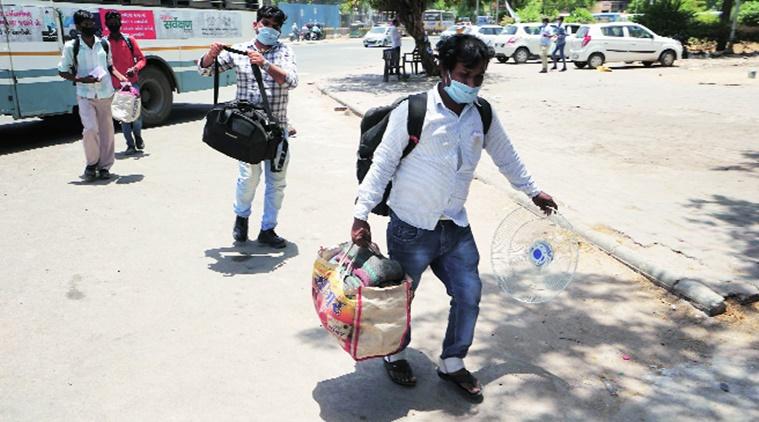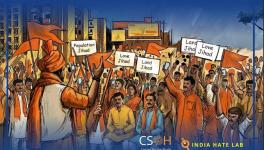Migrant Workers Stuck in Quagmire

The Supreme Court has finally passed the desired judgement, though too late, regarding the return of migrant workers to their homes. The SC has ordered that the Centre and the state governments must ensure that the migrant workers reach their destination within 15 days. So far so good.
Since after the lockdown was imposed, terrifying stories of migrant workers have been reported. We read or watched tales of unprecedented agony, starvation, trauma and death of many workers walking back home. This in itself speaks volumes about the government’s failure.
On the other hand, the Centre for Monitoring Indian Economy(CMIE) reported that the unemployment rate has reached 27% and the rate of ‘willingness to work’ of the workers in the cities fell from 74% to 38%. It implies that a fairly large section of workers (especially migrants) just does not want to stay in the cities and intends to go to their respective home states.A newspaper report from a few weeks ago had a caption, “Will eat roti with salt, but won’t come back to the city.”
The resultant large-scale reverse migration has shattered the urban development models that had been adopted for the last many years. It has also exposed the hollowness of the slogan of ‘sustainable cities’ and put a question mark on the sustainable development goals (SDGs)—to be achieved by 2030. Of the 17 SDGs, nine focus on poverty alleviation. Smart Cities and AMRUT [Atal Mission for Rejuvenation and Urban Transformation] cities were the two major flagship programmes of the Modi government’s urban development model. Both have faltered invariably. The “smart” or the “resilient (e.g. Surat)” cities apparently were the worst performers and least responsive as far as the migrant workers’ crisis is concerned. The agonised and furious migrant workers now know that staying back in the cities would starve them to death.
After almost 80 days of the lockdown, some of the migrant workers who have gone back are caught in a quagmire. One of the principal reasons for their migration to cities in the first place was the distress in the agrarian sector and dearth of work opportunities in the countryside. It is a quagmire for them because in the cities, if they migrate back—which I argue they will—there is no immediate possibility of improved working conditions.
The reasons for the migrant workers' immediate exodus after the announcement of the lockdown are systemic and without the inertia being broken, the patterns of urbanisation being followed in India will further worsen their situation.
One of the primary reasons for unsustainable urbanisation and for such a large exodus from the cities is that in India, urbanisation is delinked from industrialisation as it happened in most of the European cities. The urbanisation of the 19th century was preceded by industrialisation. The present form of urbanisation, which quantitatively is phenomenally large, has a different characteristic qualitatively. This form is more based on the information economy or as it is called in popular terms, the ‘information communication and technology’ or ICT model. This shift towards ICT has also brought in interesting changes in the qualitative build-up of the city spaces. This shift towards ICT has been accompanied with changing class structures, altered space economies, and a new urban politics, which is quite exclusionary.
Henri Lefebvre, the renowned Marxist philosopher and sociologist wrote about this change: “[T]he world was on the verge of a fundamental transformation where urban would become more or less co-terminus with the social; that we needed to think in terms of an encompassing urban society instead of discrete cities versus rural surroundings.” He further argued that “the urban problematic becomes predominant…[and] the search for solutions and modalities unique to urban society become foremost… The urban problematic (becomes) worldwide”.
Also watch: COVID-19: Indian Govt. Failed to Effectively Use Lockdown Period
We are experiencing the fallout of this worldwide phenomenon of global urban linkages where the entire world is now plagued by a deepened crisis.
But Indian cities exhibit another interesting feature: the rural-urban continuum. These cities are not completely delinked from the rural; rather, are part of the continuum. The migration from the rural to urban was not because of the pull factor from the cities, rather due to the push factor from the villages, which are already in distress. The extended family from the village migrating to the cities did not break in urban India; rather, they flourished in the cities.
Many urbanists have commented that the urbanisation in India, which should have focussed more on large labour-intensive industries in the cities, instead jumped to more skill-based work. This led to a strong fragmentation in the cities and humongous inequality got accentuated. Massive informalisation of the economy took place and informalisation of labour markets and migration have led to labour market segmentation and fragmentation in which the socially most vulnerable groups, such as those belonging to scheduled castes and scheduled tribes, are usually placed.
McKinsey Global Institute, in a report, has stated that India needs to spend Rs 9.74 million crore on cities by 2030, with Rs 5.31 million crore for capital expenditure. The largest demand for capital spending would be for affordable housing followed by mass transit. If affordable housing is excluded, the capital expenditure requirement till 2030 would be Rs 3.54 million crore. The McKinsey study finds that India’s per capita spending on cities is $US 50, including capital and operational expenditures. It amounts to just 14% of China’s $US 362, less than 10% of South Africa’s $US 508 and less than 3% of the United Kingdom’s $US 1,772. In terms of capital expenditure, India’s per capita annual urban spending is $US 17 as against $US 116 in China, $US 127 in South Africa and $US 391 in the United Kingdom. India needs to channel $ 1.2 trillion to capital expenditure in cities to build the infrastructure required to sustain them. The government had sought private capital to fill in the gap and invest in Indian cities, but private investors were more interested in the information economy i.e., the ICT. This model has further led to the widening of the gap between the various working-class groups in the cities and thus raise a big question regarding the sustainability of these cities.
Despite such a scenario and no leapfrog intervention to break the inertia so far, the migrant workers will be coming back to the cities. Early signs have already been noticed. These signs are from cities like Ludhiana, Patiala and Jalandhar in Punjab where workers from UP, Bihar and Odisha are being contacted and are being offered bus journeys to travel back to these cities. Buses have been sent to Pilibhit in UP and Motihari in Bihar. Similarly, the chief minister of Himachal Pradesh and some of the rich peasant groups in the state have colluded together to get migrant workers from Nepal to get them to work in apple orchards as the harvest season is just a few weeks away. Actually, labour demand in farms, industries and lack of prospects back home have spurred another movement; movement of migrant workers coming back to the cities and getting stuck in this quagmire.
There has been a spate of webinars and online discussions on how to make the cites more decent for the migrant workers. The changes in labour laws by UP, Madhya Pradesh and a few other states, however, further compound the problem. But the role of city governments in becoming more crucial, which cannot be neglected.
Some of the interesting takeaways in a recent webinar I attended need to be highlighted:
➤ The urban informal workers must be given social protection through employment guarantee, access to food security, eligibility to avail health facilities and access to housing/rental or labour hostels. Further, the scope of the 74th constitutional amendment must be stretched and migration should become an essential part of it.
➤ The proposal to establish a Migration Commission is a welcome step. However, without a robust and proper database collection system, this will not work. We have seen what has happened to the Building and other Construction Workers’ Board. In a large number of cities, not even 15r% of the workers were registered with it. Hence, the migration commission should have a dynamic registration system.
➤ There should be a mechanism to set up coordination between various ministries. At the city level, it should be handled by the city governments instead of the district administration, where the answerability is a low-key affair.
Get the latest reports & analysis with people's perspective on Protests, movements & deep analytical videos, discussions of the current affairs in your Telegram app. Subscribe to NewsClick's Telegram channel & get Real-Time updates on stories, as they get published on our website.























